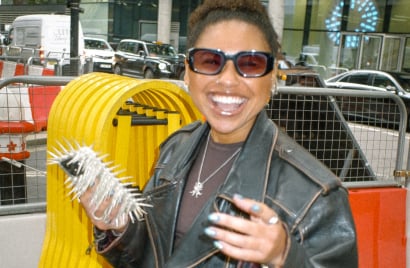
Supporting women through the messy middle of their careers
International Women’s Day may well be over, but progressive agency leaders remain focused on supporting women at every stage of their careers.

Kirsty Hathaway, Executive Creative Director at Joan London, on the new era of entertainment, making work you want to make and authentic influence.

If you live or work in London you won’t be surprised when I tell you that one phone is stolen every six minutes in the city. Phone snatching is as much a part of life in the capital as delays on the Northern Line.
In October this year, creative agency Joan London launched a tongue-in-cheek campaign to utilise creativity as a tool to raise awareness.
The agency launched theunsnatchable.com, a series of phone cases designed to counter phone thefts. These included the ‘Original Spike Cover’ and the ‘Residing Curse Cover’ which, according to the website, casts ‘a thousand lives of shame and suffering upon the one who snatches.’ The campaign successfully punctured culture with earned reach and busted the industry myth that there simply isn’t time for passion projects. A myth that arguably leaves creative agencies too busy to be creative.
Kirsty Hathaway, Executive Creative Director at Joan London, says that the campaign was focused on cut through. She explains: “Phone snatching has been getting a lot of media attention, which is great. We all know that media attention drives awareness, but it is a story amongst many other stories and wasn’t driving quite enough cut through. Our strategy and ambition was to use creativity with ridiculousness and humour at the core to create cut-through to drive awareness of the issue and, ultimately, more individual awareness of the issue and the fact that it can happen to anybody.”
She continues: “The Unsnatchable phone case collection hit these points. But, it was the spikey prototype that really had it all. It landed the comprehension in seconds. It was beautifully designed and crafted, which made it visually appealing to grab attention. Look further and the total and utter ridiculousness and infeasibility of a phone case like this made people want to learn more, share, comment and even create their own content around it.”
Creating something that is beautiful, ridiculous and also addresses a serious issue hits the beats to be able to land in culture outside of adland.
Kirsty Hathaway, Executive Creative Director at Joan London


The campaign's success is rooted in three truths; the honest scale of the problem, the humour of the approach and the shareability of the story.
Hathaway explains: “The talkability was great as TikTokers picked it up, media outlets around the world covered it and the comments just blew up. Creating something that is beautiful, ridiculous and also addresses a serious issue hits the beats to be able to land in culture outside of adland.”
At a time when so many brands are seeking to better connect with culture, the commercial sense of an agency flexing its creative muscles this way is clear. Yet in an industry in which time is arguably the most finite and precious resource, how important is it for agencies to create the space for culture-piercing campaigns such as this?
“I believe we have some of the best brains and minds at creative agencies. On top of that, we have ambition where people want to create great things, things that they are proud of,” says Hathaway.
She continues: “Our job is to be tapped into culture and to bring the best creative ideas as solutions. So we have the tools, the means and the ambition to create culture-piercing work – work that can hopefully drive positive change. But also, have a great time while doing it. I think that it’s important for all agencies to be thinking about the kind of work they want to do and, well, just do it!”
The cultural currency of The Unsnatchables campaign underlines the power of humour in advertising. If there was ever a year which demanded some much-needed light relief, 2024 is it. Yet arguably, humour remains the most under-utilised tool in modern marketing.
“Humour has historically been something that British advertising does famously well. However, the last decade or so has seen a significant step change to purpose, which, not going to lie, has been an important part of where we have been as a society and how advertising is reflecting that of culture,” says Hathaway.
She continues: “However, I think that everybody can feel the change afoot. Again, part of that is reflecting what is happening in culture and what the audience is craving, but research from places like Oracle found that 90% of consumers are more likely to remember an ad that made them have a chuckle and 72% of consumers would choose a humorous brand over others. With Cannes Lions also appreciating the importance of humour in work with their new humour category in the ‘Cultural and Context’ sections of the awards, it’s clear that, if it is still under-rated, this is currently changing.”
At a time when the myth of cancel culture has its toxic tentacles around the industry, the truth is that humour isn’t always easy. It can make brands uncomfortable to take on the perceived risk of doing things differently.
Hathaway explains: “It is worth acknowledging that to create humorous advertising does and can take some guts. To strike the tone just right, to crack just the right gag at just the right time is no mean feat. It takes time, thought and craft – as well as sensitivity. But the upside resulting in more memorable work makes the risk and the effort oh-so worthwhile.”
It is a trend which is particularly powerful in the festive advertising season. As Hathaway says: “Brits love a Christmas ad. More so than anywhere else in the world. Brits also have a phenomenal sense of humour in the perfect British dry wit. In a time when, let’s face it, things are really quite tough, humour allows us to take a beat and enjoy a little endorphin from a chuckle.”
Those little moments of light relief also lean into the emerging trend of long-form entertainment as a vehicle for brand building.
“Advertising leaning more into entertainment isn’t a new trend, but it still isn't the status quo for work we put out there. At Joan we are obsessed with creating work that does cut through with the audience and leaning into the principles of entertainment is a sure way to continue to drive resonance,” says Hathaway.
She also predicts the shift towards humour will continue apace in 2025. “I am excited to see all comms have more humour. From the likes of Ryan Air who has long been leaning the lolz on TikTok to Specsavers who have humour intertwined in their DNA, I think we are going to see more and more brands develop their personalities,” she adds.
Personality will also top the agenda when it comes to brands embracing influencer marketing to its full potential. Hathaway explains: “There are so many avenues that have not yet quite been explored with how brands and influencers can create meaningful and impactful relationships. How we cast influencers outside of follower counts and engagement metrics and create more long-term relationships that can push into the earned, owned and paid channels I think is really exciting”.
At a time when the economic environment is hostile, creating the space to look outwards, lean into making some unexpected work and lead with creativity has never been more important. Sparks of good ideas can only light within cultures that ensure creative leaders have the space to make new ideas a reality.
Looks like you need to create a Creativebrief account to perform this action.
Create account Sign inLooks like you need to create a Creativebrief account to perform this action.
Create account Sign in